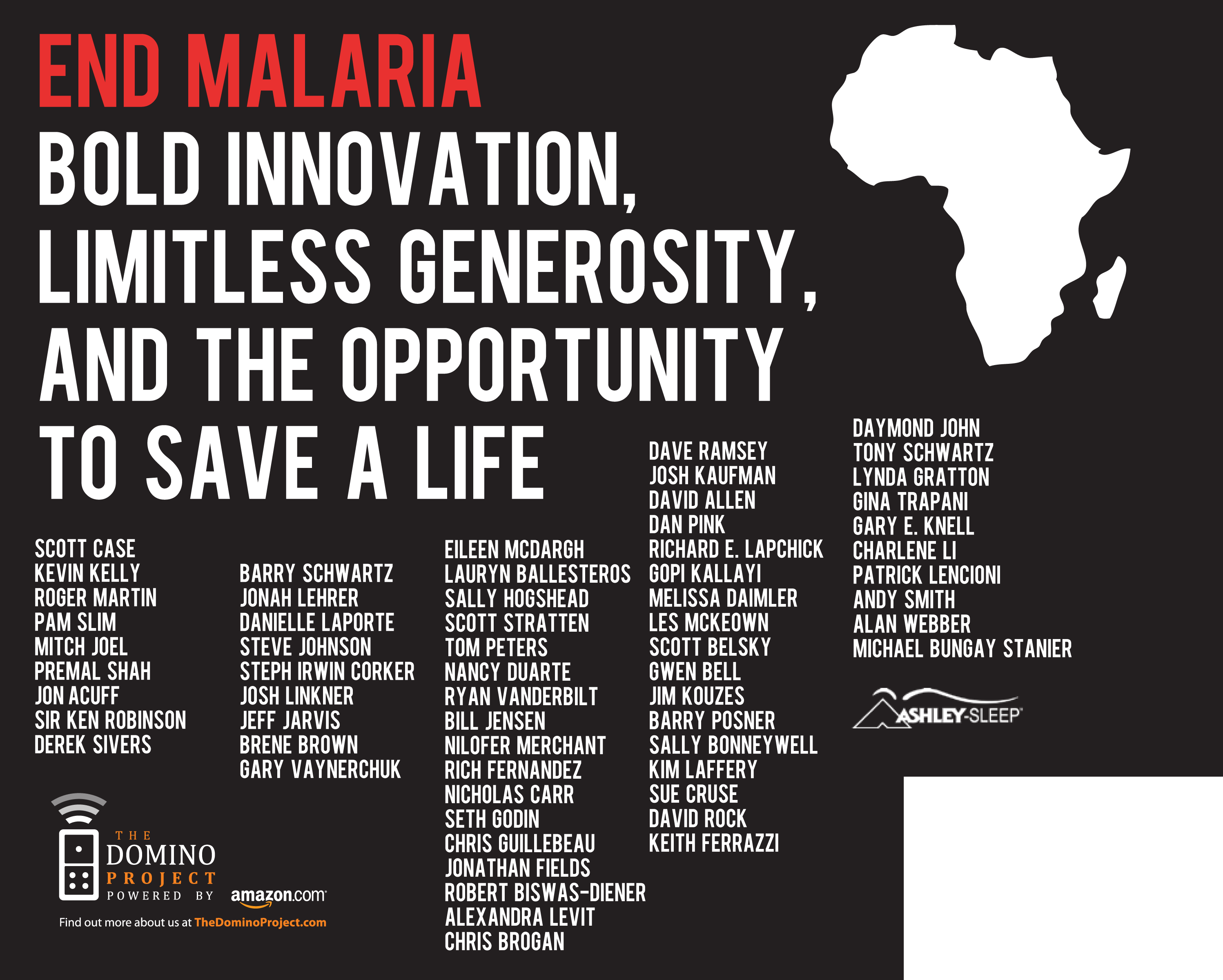Guest post by Seth Godin and Michael Bungay Stanier.
The blog connected with endmalariaday has more content than anyone could ever ever want. And that’s a bit of a problem, because more content is not going to help us sell more books, because it solves the problem “what’s in this book” rather than creating a problem “I wonder what’s in this book.”
I think what we need the authors to do is create a different problem: “You’re a good person and good people are buying this book”. There’s no shortage of stuff to read (with or without our book) but there is a shortage of easy and cheap ways to demonstrate your goodness, to be part of this tribe, to participate in a meaningful, efficient way that one can be proud of.
The big win, then, is for authors to be relentless in pushing this obligation/opportunity. “Here’s the book, take my word for it, it’s fabulous, and it’s important. It has content that will stick with you at the same time it has a benefit that you’ll remember for a long time. Buy a book, save someone’s life. How often do you get to do that?”
I fear that if we try to sell this merely as a book worth reading, we will not move enough fingers to click.
Bullet point summary of the project
The book is called: End Malaria: Bold Innovation, Limitless Generosity, and the Opportunity to Save a Life
$20 from every sale will go to Malaria No More. That’s 100% of the Kindle price, and 80% of the hard copy (The remaining $5 covers production costs.)
None of the contributors or the publishing house are taking any money from sales, and Amazon makes no profit
The book has 62 thought leaders (download PDF list of contributors) writing around the topic of Great Work – how to do more of the stuff that matters and less of all the other stuff that fills up your day
Includes such luminaries as Tom Peters, Gary Vaynerchuk, Sir Ken Robinson, Brene Brown, David Allen, Sally Hogshead and Mitch Joel
Divided into eight key areas of insight, including: Create Freedom, Disrupt Normal and Take Small Steps
End Malaria is edited by Michael Bungay Stanier and published by The Domino Project. It has an introduction from Scott Case, Vice Chair of Malaria No More
$20 sends a mosquito net to a family in need and supports life-saving work in the fight against malaria
Malaria No More’s mission is to end malaria in Africa by 2015
A child dies every 45 seconds from malariaEnd Malaria, https://www.EndMalariaDay.com,/a> , is an astonishing new book by more than sixty best selling business authors and social thought leaders who joined together to share information in a book whose entire profits go to buy malaria bed nets. Malaria is a disease that causes more childhood death than HIV/AIDS.
Malaria bed nets are simple nets that hang over a window or a bed. They’re treated with a chemical that mosquitoes hate. The mosquitoes fly away, they don’t bite, people don’t get malaria.
Every single penny spent on the Kindle edition goes to Malaria No More, giving them enough money to buy one or two bednets and to deliver them and be sure they’re used properly. Low overhead, no graft, no waste. Just effectiveness. None of the authors or anyone at the Domino Project receive money to be part of this project.
Wait, there is one ulterior motive: We hope you are inspired. One of the sixty plus contributors might share a gem or spark an idea. The book is a collection of essays from 62 business and social thought leaders about the key drivers to live a life of meaning and impact. Contributors to the book (all of whom donated their work) include David Allen, Tom Peters and Keith Ferrazzi; TED speakers Brene Brown and Sir Ken Robinson; New York Times’ best-sellers Jonah Lehrer, Gary Vaynerchuk and Dan Pink; Daymond John and Dave Ramsey; and leaders from organizations such as Google and GlaxoSmithKline.
There’s a second motive: Stepping up feels right. It’s a few clicks to buy a book and for the rest of the day, or even a week, you’ll remember how it felt to save someone’s life.
END MALARIA was born out of a passion to save lives by author and Senior Partner of Box of Crayons Michael Bungay Stanier. Teaming up with marketing and publishing innovator and creator of Squidoo.com Seth Godin, they found a way to sell a book and give away all of the profit in the fight against malaria.
” This is the power of authors working together, the power of ebook distribution and most of all, the power of people who care to make a difference. Over and over, we’re seeing that a new generation cares about business not just as a way to make money, but as a way to make a difference. These authors (and their readers) are making a difference at the same time they’re saving lives.” – Seth Godin.
End Malaria Day is April 25, Twitter #EndMalariaDay , www.Facebook.com/endmalariaday







